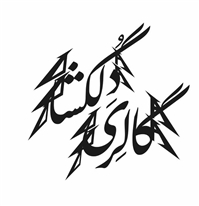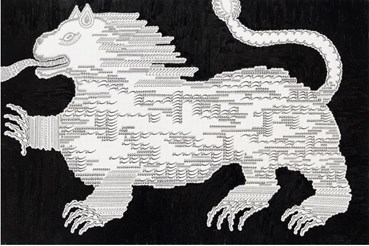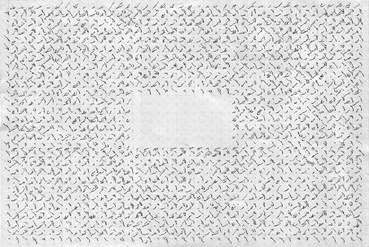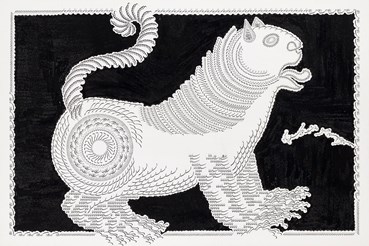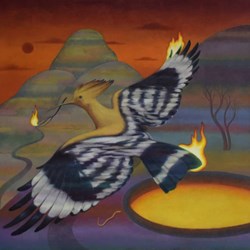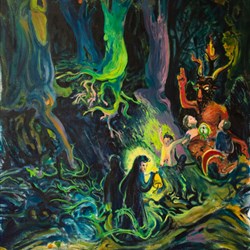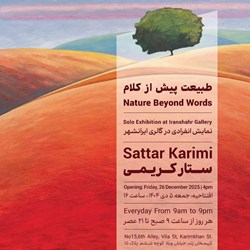24 Nov - 22 Dec, 2023

Statement:
Imagine that you have selected the paintbrush tool in a computer software like Photoshop, and have also selected black color for the brush. Next, there is a section for selecting the type of brush. There are different options available to you. You can choose a pen-like brush with different diameters, or change its transparency, or select a paintbrush or calligraphy pen with your desired thickness. You can even choose different textures. Hundreds of choices are available to you. Now, continue this imaginary path and assume that the options you have selected for the brush’s tip are Nastaliq and Shekasteh-Nastaliq hands. You shake the brush like a magician and your design appears on the page with the texture of your desired words. You draw clouds made of the Persian letter Sīn or the word [Topol] and drops made of the same word fall down like rain. You have made raindrops out of the word [Topol], only smaller in size. You enjoy this a bit more and continue until you have a delightful experience. This experience has a lot of technical similarities to what Mina Masoumi does.///
Masoumi’s pen here is not a calligraphy pen, but rather calligraphy itself. The texture of her pen is her own Shekasteh-Nastaliq script and she makes crosshatches with her very words. The difference between the artist’s experience and yours is that there is no software involved for the artist. When she starts working, she would need to invest considerable time and effort to reach results. She needs more or less an initial idea and sketch of the image she wants to create. For this kind of process, we can use an example from an Iranian poet, contrary to the author’s desire in this text: in the words of Rumi, “You are my ball and you run by the desire of my mallet in my game; I follow you, although I control your moves”. What Masoumi does not have, unlike painting software, is the ability to return, undo, erase, and redo. This is what makes her work process and practice closer to this poem. This is not to emphasize on the difficulty of her work, the required accuracy, and the time spent on creating a single work, but rather it is to highlight the value of an artist’s intellectual practice and their process in creating an artistic work, that includes the ever-changing experience of creating and reimagining. Hard work and toil do not necessarily increase the value of a work of art, and perhaps could be a sign of weakness for the artist and the lack of other features in their practice.
Masoumi entered contemporary art via her practice and background in calligraphy. One can still trace the influence of Persian poetry and literature in her references and her Mashgh practices of appropriations and adaptations. Nevertheless, her work is neither Siāh-Mashgh (overlaying of calligraphic practices) nor Khat-Naghāshi (calligraphic painting). The realm of contemporary art provides Masoumi with the opportunity to use all of her forces to create an image and an idea. In the past, to create the content of a page of a book, the poet would give the text to the calligrapher, and after writing the text, the calligrapher would hand it over to the painter, and after finishing the painting, the painter would send the paper to the binder to make a worthy frame. Masoumi, whose palette is her calligraphic hand, has taken on all these roles in her work process. Her pen is made up of letters, words, and text. She utilizes both the untapped potential of calligraphy and type, and the meanings and sounds hidden in letters and words. Her work explores the relationship between these words in Persian writing and the formal relationships of composition, drawing, and dimension. This coherence of words and sentences with each other exists both in the details of the work and in its final general form. The reason behind this is the same type of production mechanism mentioned above.
On one hand, Mina Masoumi’s visual and semantic references are intertwined with Iranian history, culture, and literature. She studies the historical identity of the lion in Iranian culture and at the same time examines the role of the lion’s image on tablets, reliefs, and sculptures. She creates a work inspired by Saadi’s “On the Manners of Conversation” and in another work references words inscribed by the Ottomans on their weapons. On the other hand, her works have a deep connection with the inner workings of modern image processing devices. Processors use letter and word encoding both to produce and present images. They convert the original image into binary code and then send them to their final destination via radio waves, wires or satellites. They eventually provide us with a device that we can convert these codes back into an image. In a more primitive form, a decade or two ago, we sent a picture of a cat or a large heart made up of letters, numbers, and parentheses to our beloved ones on our early mobile phones. Now, the modern world has provided us with the ability to exchange more than just cats whose paws are made up of the letter M.
Masoumi presents the Persian language and script structure to the audience for them to read into her work. She establishes a unique relationship between sounds, word forms, and the narratives of the image. In the scene of two cars colliding or the image of a lion colliding with a car, or the hunting of a car by a lion and the failure of the lion in this pursuit, the complexities of sound and form are increased. Now, smoke, fire, tears, and the rotation of the four wheels on the paper all have sound, and they all synesthetically open the viewer’s other senses. The playback device for these sounds is the viewer themselves —they can utter the sound of letters so that they themselves or someone else can hear them, or can silently imagine the sound of words and events.
Shabahang Tayyari, November 2023



